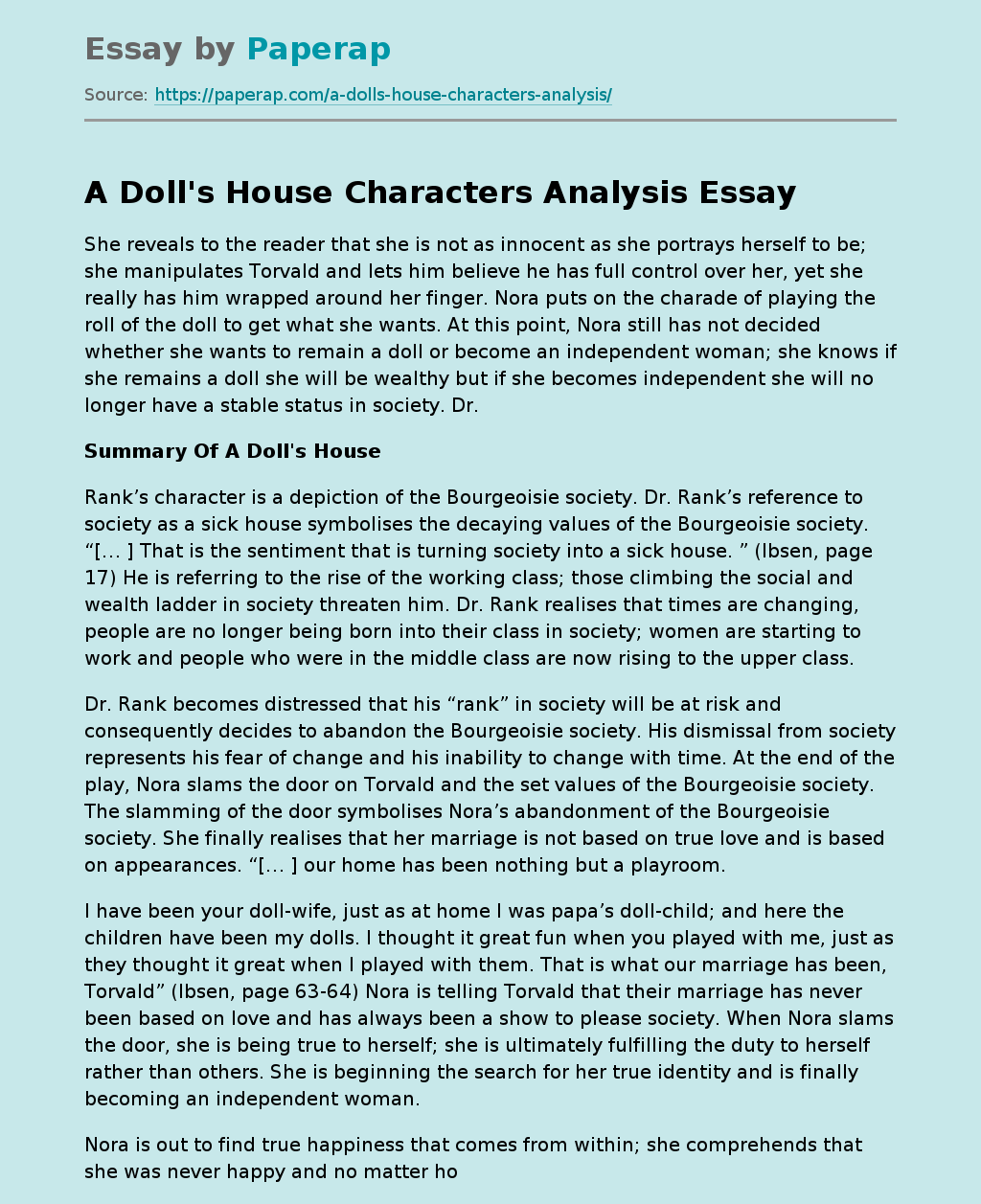A Doll's House Characters Analysis
She reveals to the reader that she is not as innocent as she portrays herself to be; she manipulates Torvald and lets him believe he has full control over her, yet she really has him wrapped around her finger. Nora puts on the charade of playing the roll of the doll to get what she wants. At this point, Nora still has not decided whether she wants to remain a doll or become an independent woman; she knows if she remains a doll she will be wealthy but if she becomes independent she will no longer have a stable status in society.
Dr.
Summary Of A Doll’s House
Rank’s character is a depiction of the Bourgeoisie society.
Dr. Rank’s reference to society as a sick house symbolises the decaying values of the Bourgeoisie society. “[… ] That is the sentiment that is turning society into a sick house. ” (Ibsen, page 17) He is referring to the rise of the working class; those climbing the social and wealth ladder in society threaten him.
Dr. Rank realises that times are changing, people are no longer being born into their class in society; women are starting to work and people who were in the middle class are now rising to the upper class.
Dr. Rank becomes distressed that his “rank” in society will be at risk and consequently decides to abandon the Bourgeoisie society. His dismissal from society represents his fear of change and his inability to change with time. At the end of the play, Nora slams the door on Torvald and the set values of the Bourgeoisie society. The slamming of the door symbolises Nora’s abandonment of the Bourgeoisie society. She finally realises that her marriage is not based on true love and is based on appearances. “[… ] our home has been nothing but a playroom.
I have been your doll-wife, just as at home I was papa’s doll-child; and here the children have been my dolls. I thought it great fun when you played with me, just as they thought it great when I played with them. That is what our marriage has been, Torvald” (Ibsen, page 63-64) Nora is telling Torvald that their marriage has never been based on love and has always been a show to please society. When Nora slams the door, she is being true to herself; she is ultimately fulfilling the duty to herself rather than others. She is beginning the search for her true identity and is finally becoming an independent woman.
Nora is out to find true happiness that comes from within; she comprehends that she was never happy and no matter how much money she had, it cannot replace the happiness true love brings. ” No, I have never been happy. I thought I was, but it has never really been so. ” (Ibsen, page 63) Nora is telling Torvald that she thought she was happy but that happiness was only temporary; she is telling him that true love can only bring permanent happiness. Nora is no longer being nai? ve and has successfully transformed from a doll to a woman! Ibsen’s play is based on self-realisation and being true to oneself.
He is showing society that times are changing and women should be treated as individuals with minds of their own rather than doll’s. He is trying to show society that money can only buy materialistic goods, it can not buy love, or true happiness. Ibsen is foreshadowing the changes in the future through Nora’s transformation from a doll to a woman; he is giving hope to the women of the Bourgeoisie society that there is room for change. Ibsen is sending a message to society; a woman’s duty does not always have to be to others and there should be a balance between a woman’s duty to oneself and her duty to others.
He is telling women around the world to always be true to their hearts, and to never pretend to be someone they are not. Through Dr. Rank Ibsen is showing that it is healthy to have a fear of change, but change is also healthy; one should not run away from change because change is always at a constant. 1 2 Show preview only The above preview is unformatted text This student written piece of work is one of many that can be found in our GCSE Henrik Ibsen section. Download this essay Print Save Not the one?
A Doll's House Characters Analysis. (2019, Dec 05). Retrieved from https://paperap.com/a-dolls-house-characters-analysis/

